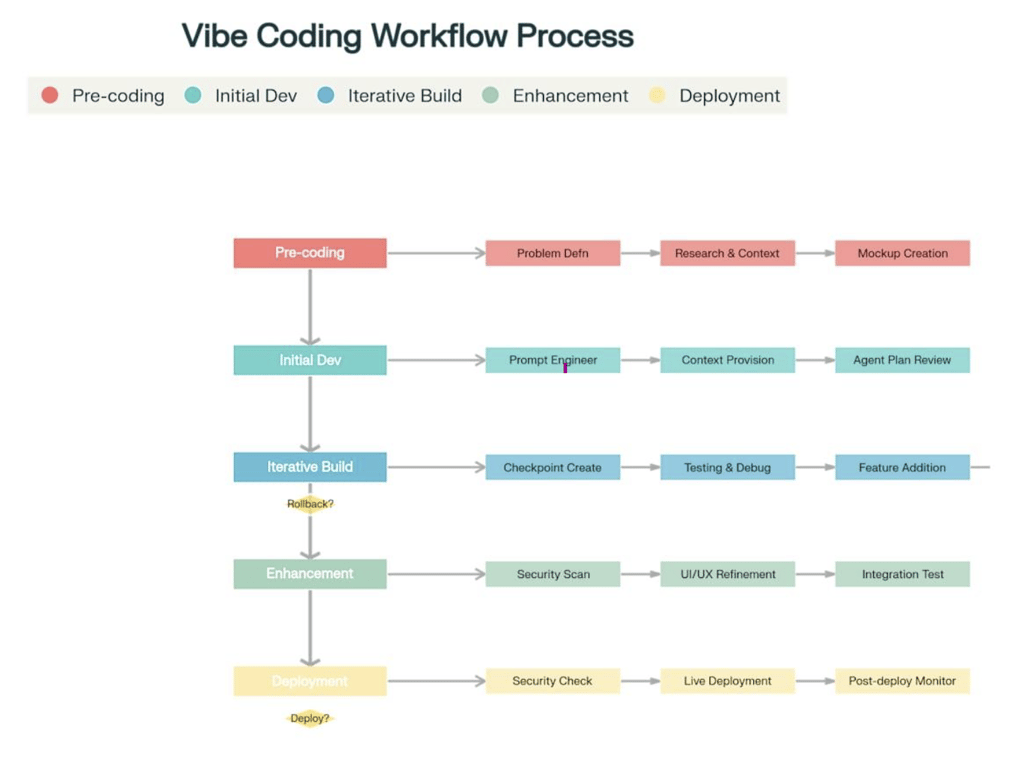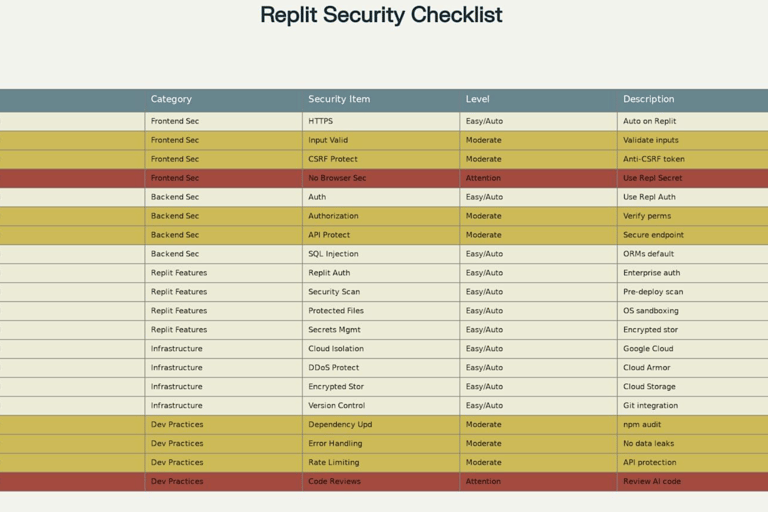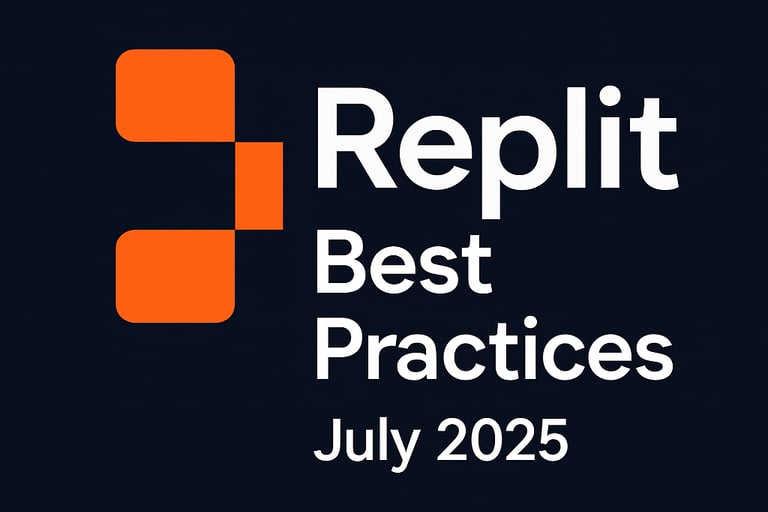Extensive reseach on Replit Best practices: July 2025
This blog includes the learnings from 100+ hours of vibe coding on Replit and other vibe coding tools
7/1/202510 min read
The Complete Guide to Vibe Coding Best Practices with Replit: July 2025 Research Report
This comprehensive report examines the latest best practices for vibe coding with Replit, drawing from extensive research across Reddit communities, YouTube tutorials, official documentation, technical blogs, and expert insights gathered in July 2025. Vibe coding has emerged as a transformative approach to software development, democratizing app creation through natural language interaction with AI agents.
What is Vibe Coding and Why It Matters in 2025
Vibe coding, a term coined by AI researcher Andrej Karpathy in February 2025, refers to a development approach where creators "fully give in to the vibes, embrace exponentials, and forget that the code even exists"[1]. This methodology allows both technical and non-technical users to build sophisticated applications by describing their intent in natural language rather than writing traditional code.
Key Characteristics of Modern Vibe Coding
The evolution of vibe coding in 2025 has established several core principles that distinguish it from traditional development approaches. First, intent-driven development focuses on describing desired outcomes rather than implementation details. Second, AI collaboration treats AI agents as junior developers who handle technical execution while humans provide strategic direction. Third, rapid iteration cycles embrace experimentation and quick feedback loops over perfect initial implementations[2].
The Replit Advantage
Replit has emerged as the premier platform for vibe coding due to its integrated cloud-based environment that eliminates setup complexity. Unlike traditional development workflows that require local installations and complex configurations, Replit provides an entire development ecosystem accessible through a web browser[3]. The platform's integration of AI agents, security features, and deployment capabilities creates what industry experts call "the pit of success" – an environment designed to guide users toward secure, well-architected applications by default[4].
The Three Pillars of Successful Vibe Coding
Research from leading practitioners and community discussions reveals that successful vibe coders possess three essential traits that form the foundation of effective AI-assisted development.
Agency: Taking Ownership of the Process
Agency represents the willingness to take action and figure out solutions independently. Successful vibe coders don't wait for perfect instructions but actively engage with the AI agent to troubleshoot issues and iterate toward solutions[5]. This involves understanding when to pause the AI, when to provide additional context, and when to break down complex requests into smaller, manageable tasks.
Curiosity: Continuous Learning and Exploration
Curiosity drives vibe coders to explore new frameworks, understand how generated code works, and ask probing questions. Many practitioners report learning more about web development through observing AI agents than through traditional educational approaches[5]. This includes asking agents to explain their decisions, researching suggested frameworks, and understanding the architectural choices being made.
Courage: Embracing Failure and Iteration
Courage involves the willingness to fail, start over, and learn from mistakes. As one expert noted, "The secret of being an engineer is just failing a lot"[5]. Vibe coding inherently involves variance in outputs – sometimes AI generates excellent solutions, sometimes subpar ones. Courageous vibe coders understand this uncertainty and use it as a learning opportunity rather than a barrier.
Comprehensive Workflow and Best Practices
The most effective vibe coding follows a structured workflow that balances creativity with systematic engineering practices. Based on analysis of successful projects and expert recommendations, the optimal approach involves five distinct phases.


Comprehensive Vibe Coding Workflow with Replit - A step-by-step guide showing the complete process from ideation to deployment
Phase 1: Vibe Product Management (Pre-Coding)
Before writing any prompts, successful vibe coders begin with Vibe PMing – thinking like a product manager to define clear requirements and scope. This involves creating mockups or wireframes, researching relevant APIs and data sources, and documenting the core features needed for a minimum viable product[5].
Key Activities:
Define the problem space and target users
Create visual mockups using tools like Figma or simple sketches
Research domain-specific APIs and data sources using AI assistants
Document core features and user flows
Identify technical requirements and constraints
Phase 2: Context-Rich Prompt Engineering
The quality of AI-generated code directly correlates with the richness of context provided. Expert practitioners emphasize moving beyond simple text prompts to include visual elements, code examples, and detailed specifications[6].
Essential Context Elements:
Visual mockups showing desired UI/UX
Code snippets demonstrating preferred patterns
API documentation for external services
Sample data illustrating expected formats
Technical constraints specifying frameworks or requirements
Phase 3: Iterative Development with Checkpointing
Replit's checkpoint system serves as the backbone for safe iteration. Each checkpoint represents a stable state that can be restored if subsequent changes introduce problems[7]. This creates a safety net that encourages experimentation while preventing catastrophic losses.
Checkpoint Best Practices:
Create checkpoints after each successful feature implementation
Use descriptive names for checkpoint identification
Test functionality before creating new checkpoints
Leverage rollback features when stuck in problematic loops
Preview previous states without full rollback when possible
Phase 4: Security-First Enhancement
Modern vibe coding requires proactive security consideration rather than retrofitting protection later. Replit's integrated security features, launched in July 2025, provide automated scanning and protection mechanisms that work seamlessly with AI-generated code[4].
Security Integration Steps:
Enable pre-deployment security scanning
Use Replit Auth for authentication requirements
Implement proper secrets management
Validate all user inputs and API endpoints
Review AI-generated code for security antipatterns
Phase 5: Testing and Deployment
The final phase involves comprehensive testing and deployment using Replit's cloud infrastructure. This includes mobile responsiveness testing, API functionality validation, and performance optimization[3].
Advanced Security Practices for Vibe Coding
Security represents one of the most critical aspects of modern vibe coding, particularly given research showing that AI-generated code can contain vulnerabilities in up to 80% of cases when not properly managed[8]. Replit's July 2025 security enhancements address these challenges through multiple layers of protection.
Comprehensive Security Checklist for Vibe Coding with Replit - Essential security measures organized by category and implementation difficulty
Built-in Security Features
Replit Auth provides enterprise-grade authentication leveraging Firebase, email verification, reCAPTCHA, device fingerprinting, and bug bounty programs[4]. This system eliminates the complexity of implementing custom authentication while providing security features that would be difficult for individual developers to implement correctly.
Security Scanning powered by Semgrep provides automated vulnerability detection before deployment. The system identifies common security issues in AI-generated code and offers one-click fixes through the Replit Agent[9]. This proactive approach prevents vulnerabilities from reaching production environments.
System-Level Protection prevents AI agents from modifying critical files like Git history, configuration files, and secrets. Unlike prompt-based restrictions, this protection operates at the operating system level, providing deterministic security guarantees[4].
Security Checklist Implementation
Research reveals that successful vibe coding projects follow a comprehensive security checklist covering frontend protection, backend security, and operational practices[10]. Frontend measures include HTTPS enforcement (automatic on Replit), input validation and sanitization, CSRF protection, and proper secrets management. Backend security requires authentication implementation, authorization checks, API endpoint protection, and SQL injection prevention through ORM usage.
Dynamic Intelligence: July 2025's Game-Changing Features
Replit's introduction of Dynamic Intelligence in July 2025 represents a significant advancement in AI agent capabilities, providing enhanced reasoning and autonomous problem-solving features[11].
Extended Thinking Mode
Extended Thinking instructs the AI agent to analyze problems more thoroughly, considering multiple approaches and edge cases before implementation. This mode proves particularly valuable for complex debugging scenarios, architectural decisions, and open-ended requirements where simple solutions might not suffice[12].
Use Cases for Extended Thinking:
Complex debugging challenges with multiple interacting systems
Architectural decisions affecting long-term maintainability
Integration with unfamiliar third-party APIs
Performance optimization requiring systematic analysis
UI/UX decisions with multiple stakeholder considerations
High Power Model Integration
High Power Mode upgrades the AI agent from Claude Sonnet to Claude Opus, providing superior performance for complex reasoning and large context processing. This enhancement proves most valuable for sophisticated integrations, major refactoring efforts, and performance-critical optimizations[12].
Intelligent Web Search
Web Search capabilities enable the AI agent to research current information, find relevant documentation, and stay updated with the latest best practices. This feature addresses the common challenge of AI agents working with outdated information, particularly important for rapidly evolving frameworks and APIs[11].
Community Insights and Expert Recommendations
Analysis of community discussions across Reddit, YouTube, and professional forums reveals consistent patterns among successful vibe coders and common pitfalls to avoid.
Staff Engineer Perspectives
Staff software engineers emphasize the importance of application architecture planning before beginning development[6]. This includes mapping user flows, understanding data relationships, and considering scalability requirements. They recommend creating Product Requirements Documents (PRDs) and providing extensive context to AI agents rather than expecting them to infer requirements.
Experienced Practitioner Strategies
Veteran vibe coders have developed sophisticated strategies for managing AI agent interactions[13]. These include starting new chat sessions for each major feature, maintaining organized documentation of successful patterns, and using multiple AI agents for different aspects of development (one for planning, another for implementation).
Advanced Techniques:
Using separate AI instances for different roles (planning vs. implementation)
Maintaining prompt libraries for common patterns
Creating reusable template structures for similar projects
Implementing systematic testing protocols for AI-generated code
Establishing rollback criteria to avoid extended debugging sessions
Common Failure Patterns and Solutions
Community analysis reveals several recurring challenges that can derail vibe coding projects[14]. Agent loops occur when AI gets stuck repeatedly attempting the same failed solution. The recommended resolution involves stopping the agent, providing more specific context, or starting a fresh session with refined requirements.
Scope creep represents another common issue where AI agents add unnecessary complexity or features beyond the original specification. Successful practitioners maintain strict feature boundaries and use incremental development approaches to prevent this problem.
Context degradation happens during extended sessions where AI agents lose track of project goals or architectural decisions. Regular checkpoint creation and session management help maintain consistency throughout development cycles.
Workflow Management and Organizational Strategies
Recent developments in Replit's platform include enhanced workflow management capabilities designed to streamline repetitive development tasks and improve project organization[15].
Workflows Integration
Replit Workflows allow developers to define sequences of tasks that can be executed with single-button clicks[15]. This capability proves particularly valuable for complex deployment procedures, testing protocols, and development environment setup. Workflows can chain multiple commands together, handle parallel execution, and provide isolated output streams for easier debugging.
Project Organization Best Practices
Successful vibe coding projects maintain clear organizational structures that facilitate both AI agent understanding and human maintenance[16]. This includes logical file organization, consistent naming conventions, and clear separation between frontend and backend components.
Organizational Principles:
Maintain clear separation between client and server code
Use descriptive file and folder naming conventions
Implement consistent coding patterns across the project
Document architectural decisions and API contracts
Establish clear data flow and state management patterns
Cost Management and Efficiency Optimization
Understanding Replit's pricing model and optimizing for cost-effectiveness represents a crucial aspect of sustainable vibe coding practices, particularly with the introduction of effort-based pricing in July 2025[17].
Effort-Based Pricing Understanding
Replit's new effort-based pricing model aligns costs with the actual computational effort required for different tasks[17]. Simple modifications typically cost less than the previous $0.25 per checkpoint, while complex implementations may cost more but provide better value through comprehensive solutions. This model encourages thoughtful prompt engineering and reduces the penalty for minor adjustments.
Cost Optimization Strategies
Strategic prompt design involves breaking complex requests into focused, well-defined tasks that can be completed efficiently. Checkpoint management requires balancing development safety with cost considerations – creating checkpoints at logical milestones rather than after every minor change.
Planning utilization takes advantage of free planning phases where AI agents propose implementation approaches before beginning billable work. This allows developers to refine requirements and approach before committing to expensive implementation cycles.
Performance Monitoring and Quality Assurance
Maintaining high-quality standards in AI-generated applications requires systematic monitoring and testing approaches that account for the unique characteristics of vibe-coded projects.
Testing Strategies for AI-Generated Code
Incremental testing involves validating functionality at each checkpoint to catch issues early in the development cycle. Cross-browser compatibility testing ensures applications work correctly across different devices and browsers, particularly important for Replit's cloud-based deployment model.
Performance monitoring includes tracking application response times, database query efficiency, and user interface responsiveness. Many practitioners use browser developer tools extensively to monitor network requests, console errors, and performance metrics throughout development.
Quality Assurance Protocols
Code review practices for AI-generated code focus on architectural soundness, security considerations, and maintainability rather than syntax correctness. Documentation validation ensures that AI agents accurately document their implementation decisions and architectural choices.
Future Trends and Emerging Patterns
Analysis of current developments and community discussions suggests several emerging trends that will shape vibe coding practices in the coming months.
AI Agent Autonomy Evolution
The trajectory toward more autonomous AI agents suggests future capabilities will include extended problem-solving sessions, automatic testing and validation, and proactive optimization recommendations[5]. This evolution will likely reduce the need for constant human oversight while maintaining quality and security standards.
Integration Ecosystem Expansion
Replit's growing integration ecosystem, including recent additions like xAI, Notion, and PayPal, indicates a trend toward comprehensive platform solutions that eliminate the need for external service coordination[18]. This integration density will likely accelerate development cycles and reduce configuration complexity.
Enterprise Adoption Acceleration
The introduction of enterprise-focused features like SCIM support, advanced security controls, and viewer seats suggests increasing adoption in professional environments[19]. This trend will likely drive additional requirements for compliance, audit trails, and collaborative development features.
Replit vibe coding platform interface showing key features
Conclusion and Recommendations
Vibe coding with Replit in July 2025 represents a mature and powerful approach to software development that balances creative freedom with engineering rigor. Success requires adopting a structured methodology that encompasses product management thinking, iterative development practices, and strategic use of AI capabilities.
The most successful practitioners combine technical understanding with product intuition, using AI agents as sophisticated tools rather than replacement developers. They maintain clear project boundaries, implement systematic security practices, and leverage Replit's integrated platform features to accelerate development while maintaining quality standards.
As the field continues to evolve, practitioners who master these foundational practices while staying current with platform developments will be best positioned to leverage the expanding capabilities of AI-assisted development. The key lies in viewing vibe coding not as a shortcut to development, but as a new paradigm that requires its own set of skills, practices, and mental models for optimal results.
The research conducted across multiple platforms and communities consistently points to the same conclusion: vibe coding success stems from combining human creativity and strategic thinking with AI execution capabilities, all within a framework that prioritizes security, iteration, and continuous learning. As this field continues to mature, these principles will likely remain constant even as the tools and capabilities continue to evolve.
References:
interests.coding_methodologies
projects.content_creation
projects.camp_organization
https://www.reddit.com/r/replit/comments/1kpuudj/replit_learnings_best_practices_after_a_month_of/
https://www.reddit.com/r/replit/comments/1kfy2aw/tips_from_an_experiences_vibe_coder/
https://www.arsturn.com/blog/designing-and-developing-with-replit-my-workflow
https://semgrep.dev/blog/2025/replit-and-semgrep-secure-vibe-coding
https://www.reddit.com/r/ChatGPTCoding/comments/1kfy0gz/my_tips_as_an_experienced_vibe_coder/
https://rpltbldrs.com/p/2025-will-be-the-year-of-the-ai-coding-agent
https://www.reddit.com/r/replit/comments/1kfdtm9/vibe_coding_tips_from_a_staff_software_engineer/
https://slashdev.io/-the-ultimate-guide-to-building-apps-with-replit-in-2025
https://www.reddit.com/r/replit/comments/1j754ym/lessons_from_48_good_of_vibe_coding_with_replit/
https://www.reddit.com/r/replit/comments/1jl0b3m/vibe_coding_useful_90_minute_primer/




Built with AI and Humans Working in Harmony
